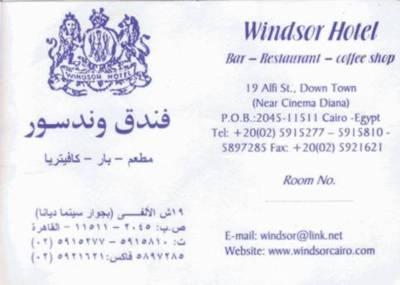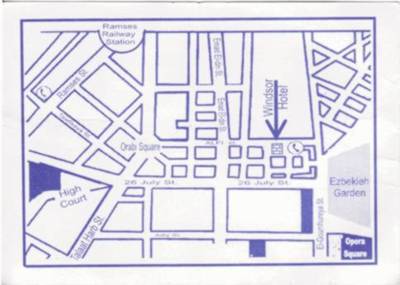 |
 |
 |
20 |
|
٢ |
 |
| 21 |
|
٣ |
| 22 |
|
٤ |
| 23 |
|
٥ |
| 24 |
|
٦ |
| 25 |
|
٧ |
| 26 |
|
٨ |
| 27 |
|
٩ |
| 28 |
|
١٠ |
| 29 |
|
١١ |
| 30 |
|
١٢ |
 |
1 |
|
١٣ |
| 2 |
|
١٤ |
| 3 |
|
١٥ |
| 4 |
|
١٦ |
| 5 |
● |
١٧ |
| 6 |
|
١٨ |
| |
|
|
|
|
|
We enjoyed an early breakfast at the Windsor, which included EN hibiscus tea AR كركاده AR karkadeh . I hadn't even known this existed before going to Egypt, but I'm glad to have stumbled on it; if I had learned about it after I missed my opportunity for a taste, I would have been highly disappointed. But now, this is what I learned after getting back: It's the same as jamaica, which I have tasted in Mexico. And this is what I learned while I was there: (In my opinion) It's unpleasant.
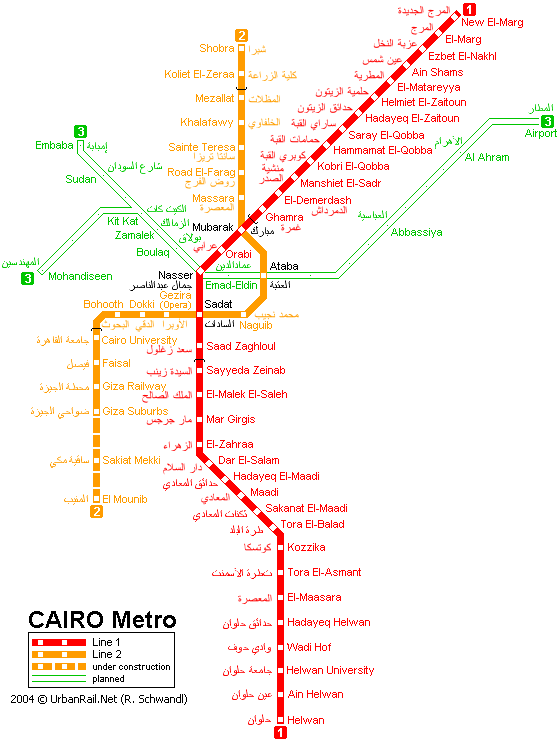 |
The Cairo Metro |
Then we set out to ride the EN Cairo Metro AR مترو الأنفاق القاهرة to the Egyptian Museum. I love public transit, and always try to make it a point to ride the metro systems wherever I go. Usually it's anticlimactic: There's not much you can do to make a train in Cairo different from a train in Atlanta. And while there are a few different styles of payment and ticket validation, by now I think I've probably seen them all. There were a few interesting things about the Cairo Metro, though:
- Even though English was everywhere, Arabic came first. It's always nice when the English juggernaut is slowed down a bit.
- The station clocks displayed Arabic numbers, which I had not seen on any public clocks elsewhere in the Middle East.
- The front two cars were reserved for women. (Or, in more detail: women were permitted in all cars regardless of circumstance; men could ride in the front two cars only if they were traveling with a close family member who was a woman.)
And the EN Egyptian Museum AR المتحف المصري , officially the "Museum of Egyptian Antiquities," was spectacular! It was so clogged with priceless ancient artifacts that it gave the feel of visiting a basement in the mansion of the world's richest, most single-minded collector. The EN Tutankhamun AR توت عنخ أمون EGY  EGY Tutankhamun Hekaiunushema exhibits are the crown jewels of the museum's collection, but I was more impressed with the immense hieroglyphic tablets and the innumerable colorful sarcophagi, which were wedged into any corner where they would fit. Unfortunately, photographs were forbidden in the museum – a stricture so rigidly enforced that cameras had to be turned in to a booth before entry and retrieved at the end of the visit. EGY Tutankhamun Hekaiunushema exhibits are the crown jewels of the museum's collection, but I was more impressed with the immense hieroglyphic tablets and the innumerable colorful sarcophagi, which were wedged into any corner where they would fit. Unfortunately, photographs were forbidden in the museum – a stricture so rigidly enforced that cameras had to be turned in to a booth before entry and retrieved at the end of the visit.
|
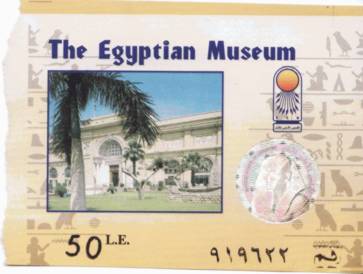 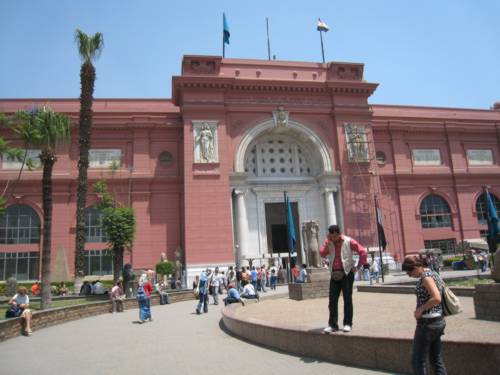
|
We napped in the hotel that afternoon, and then I went to the EN Mosque-Madrassa of Sultan Hassan AR مدرسة السلطان حسن on the recommendation of one of our taxi drivers, who said there was nothing else like it. This was a fortuitous opportunity (okay, if you're a stickler: fortuitous and fortunate): I had the name Sultan Hassan confused in my mind with a different mosque – perhaps more beautiful, but not nearly as historic – but didn't make it a priority until getting this recommendation from taxi driver, and then didn't double check to see if it was the mosque I was thinking about. I wish I had been able to see them both, but Sultan Hassan was probably the better choice.
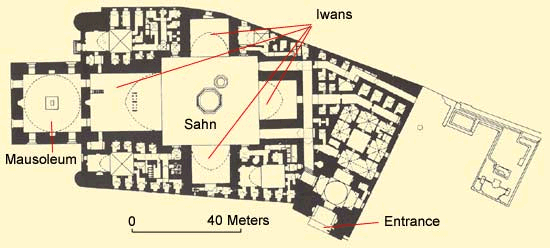 |
Sultan Hassan Mosque |
The Sultan Hassan Mosque is notable for its history, its shape, and its size. Construction was started in 1356 CE (757 AH), and was paid for with the wealth of those who succumbed to the Black Death, which swept Cairo eight years earlier (a form of financing that was considered highly controversial and unseemly at the time). It is a masterpiece of Mamluk architecture, and is sufficiently important that it is featured on the LE 100 bill, the highest denomination of Egyptian currency. The entrance, as you can see, is at an odd angle to the rest of the building. It is said that this was done so it could look up the street that runs the length of the building, and that now separates Sultan Hassan from adjacent EN al-Rifa'i Mosque AR مسجد الرفاعي , built much later, starting in 1869 CE (1286 AH). This orientation was so that the mosque could face, and thus challenge, the Citadel (specifically, the EN Saladin Citadel of Cairo AR قلعة صلاح الدين ), the seat of government with which it shared icy, and sometimes hostile, relations – so hostile, indeed, that cannon were turned on the mosque in 1517, and gunfire during the Ottoman period so weakened the dome that it had to be removed. The mosque's public space is centered on the EN sahn AR صحن (a central courtyard, open to the sky); framing the sahn on each of the four sides is an EN iwan AR إيوان (a vaulted hall, closed on three sides and open on the fourth), which was set aside for education in one of the four legal traditions of Sunni Islam: Shafi, Maliki, Hanafi, and Hanbali. It is one of the largest mosques in the world.
Then Billy and I returned to the Khan al-Khalili. With the heavy afternoon crowd we found it too busy to enjoy. So we made our way to nearby EN al-Ghouri Mosque AR مسجد القوري , and got in line earlier than planned to watch a Sufi dance demonstration that is performed once a week (we got lucky on the timing) in the mosque's AR وكالة AR wikala EN caravansary , which is not needed for its original purpose with the decline of caravan travel in modern Cairo.
car·a·van·sa·ry /ˌkærəˈvænsəri/
–noun, plural -ries
| 1. |
|
(in the Near East) an inn, usually with a large courtyard, for the overnight accommodation of caravans. |
| 2. |
|
any large inn or hotel. |
|
|
While waiting for the doors to open, an agent from the mosque invited those of us who were interested to go see its interior and to climb its minaret; I joined a couple of other people in line to do so (but Billy elected to wait at the wikala). (I'm pleased for the opportunity, but note that this is a money-making opportunity for the mosque, as admission was charged.)
We reached the top just as the speakers on al-Ghouri and every other mosque in Cairo started issuing the EN azaan AR أَذَان (call to prayer) for the EN maghrib AR مَغْرِب (sunset) prayers – which was a particularly cool experience. The azaan is really beautiful to hear, and it wasn't deafening on the minaret because all of the speakers faced out; there are variations depending on whether the mosque is Sunni or Shi'a, time of day (if Shi'a), and when and how a line about Ali might be included (if Sunni), but the basic form goes like this:
| الله اكبر |
|
Allah is the greatest |
| الله اكبر |
|
Allah is the greatest |
| الله اكبر |
|
Allah is the greatest |
| الله اكبر |
|
Allah is the greatest |
| اشهد ان لا اله الا الله |
|
I bear witness that there is no god except Allah |
| اشهد ان لا اله الا الله |
|
I bear witness that there is no god except Allah |
| اشهد ان محمدا رسول الله |
|
I bear witness that Muhammad is the Messenger of God |
| اشهد ان محمدا رسول الله |
|
I bear witness that Muhammad is the Messenger of God |
| حي على الصلاة |
|
Make haste towards prayer |
| حي على الصلاة |
|
Make haste towards prayer |
| حي على الفلاح |
|
Make haste towards welfare |
| حي على الفلاح |
|
Make haste towards welfare |
| حي على خير العمل |
|
Make haste towards the best deed |
| حي على خير العمل |
|
Make haste towards the best deed |
| الله اكبر |
|
Allah is the greatest |
| الله اكبر |
|
Allah is the greatest |
| لا اله الا الله |
|
There is no god except Allah |
| لا اله الا الله |
|
There is no god except Allah |
|
Then it was time to enter the wikala for the Sufi dance demonstration, performed by the EN at-Tanoora AR التنورة Egyptian Heritage Dance Troupe. I have pointed out my frustration with the constant expectation of tips and baksheesh in Egypt – but lest I deny you a more complete understanding, I am honor-bound to draw your attention to the fact that (1) no money was requested at this demonstration; (2) no opportunity was presented to give a voluntary donation; and (3) none of the employees ever requested or even hinted at the issue of baksheesh for their services. I don't know how they paid to keep this thing going, but it wasn't from the audience. More incredible was that pictures were allowed (even flash pictures) so I can remember and share the experience better than I had expected.
You may wonder why I have not included the term "whirling dervish." It's not offensive, and it may be accurate – but I excluded it because I was uncertain as to its accuracy for the following reasons:
- The at-Tanoora group did not use the term in its literature or in the introduction.
- A EN dervish AR درویش is a member of a Sufi religious fraternity, and it was not clear to me that the members of at-Tanoora were, indeed, Sufi. (It's possible – even likely – but unconfirmed.)
- The whirling meditative trance of the Sufi involves a posture in which the hands are placed in a distinctive oppositional stance, and the head is slightly cocked to the side; the at-Tanoora dancers did not adopt this posture, and they showed no sign of entering a trance.
After the show it was late, and we needed as much sleep as possible before our early flight out of Cairo.
The Windsor had given us a card to help taxi drivers find the place, but we hadn't had much need of it on our several taxi rides, and I had not been careful to bring it. But we had a terrible time trying to find a taxi to bring us back from al-Ghouri, as no one recognized the name "Windsor." We did eventually find one who thought he could find it, and then circled the neighborhood repeatedly until I recognized a landmark. (I doubled the fare as baksheesh to compensate for the amount of his time we had taken.)
|
Windsor Hotel Location Card |
At this point, I had started to realize that leaving the doors open (in the absence of air conditioning) was creating a problem with mosquitoes. So before bed I found my way to a pharmacy in the neighborhood looking for hydrocortisone. The assistant spoke English, but couldn't understand my request for "hydrocortisone" – but when the head pharmacist became available (after helping another customer), he understood perfectly. (Actually, it's the same word in Arabic; he shared my confusion at the assistant's inability to recognize the word.) But he recommended a different product: EN Fenistil AR فنيستيل . Actually, I think hydrocortisone would have worked better, but perhaps nothing would have worked well: These were horrendous mosquitoes, and the welts didn't heal for a couple of weeks after my return.
|

![]() EGY Tutankhamun Hekaiunushema
EGY Tutankhamun Hekaiunushema 



